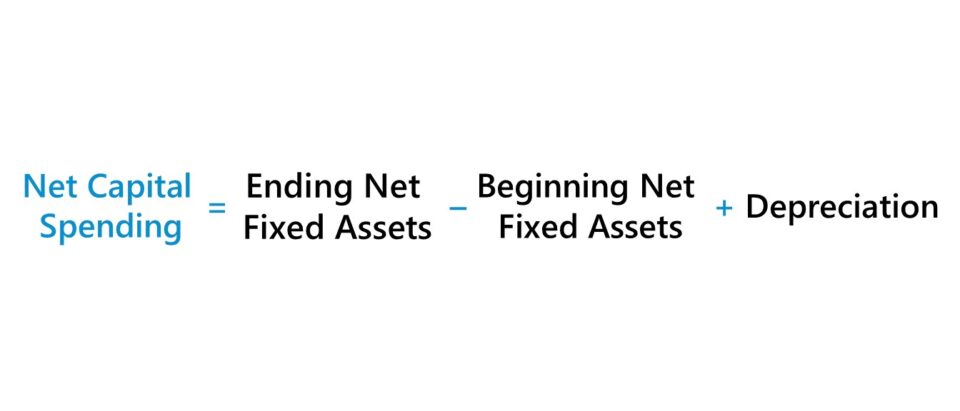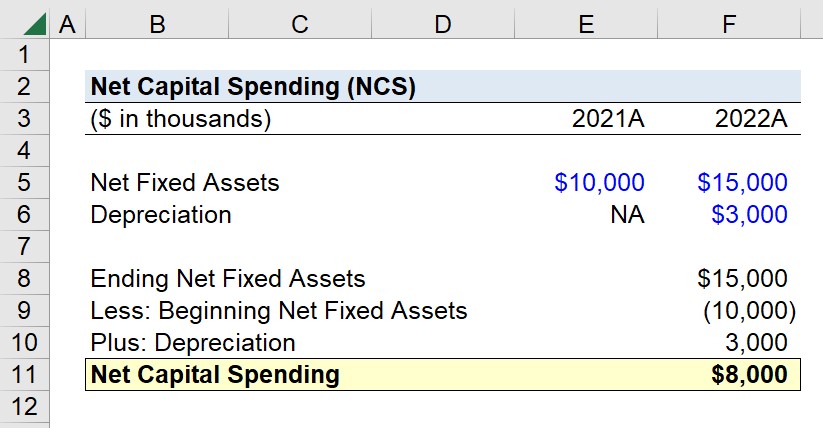What is Net Capital Spending?
Net Capital Spending (NCS) measures the difference between a company’s capital expenditure (Capex) and depreciation in a given period.

How to Calculate Net Capital Spending (NCS)
In corporate finance, the net capital spending (NCS) metric is measured to track the current state of a company’s growth trajectory, as well as to support capital budgeting decisions.
The net capital spending of a company is the amount spent on purchasing fixed assets in a particular period.
The fixed asset (i.e. PP&E) categorization refers to non-current, tangible assets that can provide economic value for more than twelve months.
For instance, manufacturers must constantly replace existing machinery and equipment to offer their customers high-quality products and reliable, on-time delivery (e.g. for the avoidance of unexpected downtimes from machine failures and quality control), as well as to abide by regulations and ensure the safety of their employees.
To calculate net capital spending, the following two steps can be followed:
- Calculate Change Net Fixed Assets → Subtract the Ending Net Fixed Assets by the Beginning Net Fixed Assets to Determine the Year-over-Year (YoY) Change
- Adjust for Non-Cash Items → Add Back the Depreciation Expense Recorded in the Current Period
Net Capital Spending Formula
The net capital spending formula is equal to the change in net fixed assets plus depreciation.
Where:
- Net Fixed Assets: “Ending Net Fixed Assets” refers to the current period balance, while the “Beginning Net Fixed Assets” refers to the prior period’s ending balance. The values of each can be found on the non-current assets section of the balance sheet.
- Depreciation: “Depreciation” is the Capex as recognized in the current period, which can be found on the cash flow statement (CFS) or in the footnotes and supplementary sections if consolidated with amortization expense.
What is a Good Net Capital Spending?
The reliance on capital spending, or “capital expenditures”, is determined by the industry in which the company operates (i.e. capital-intensive vs. capital-light). Thus, net capital spending is more relevant to capital-intensive industries, as opposed to service-oriented industries like consulting, where most of the incurred costs in the business model are related to labor.
As mentioned earlier, the net capital spending metric can also provide insights into the stage of growth at which the company is currently. If a company’s net capital spending is on the higher end relative to comparable companies in the same (or adjacent) industry, the company is implied to be in a period of high growth.
Companies with higher growth than their industry peers tend to have higher net capital spending than those with lower growth.
However, a company with disproportionate capital expenditures relative to its competitors is not necessarily a positive sign. In fact, the company might be trailing behind the rest of the industry in terms of growth and thus attempting to catch up by spending significant capital on purchasing fixed assets.
If capital spending – i.e. the change in the net fixed asset balance across a period – is equal to the depreciation expense, then the net capital spending is zero. Net zero spending signals the company is likely mature and in the later stages of its life-cycle with limited growth opportunities, which is conceptually identical to a company’s depreciation as a percentage of its capital expenditures converging to a ratio of 1.0x (or 100%).
How to Analyze Net Capital Spending in Capital Budgeting?
Thus far, we’ve discussed net capital spending in terms of tracking the trend in capital expenditures and depreciation in analyzing a company’s current (and future) growth profile.
It is important to note, however, that the term “net capital spending” can also refer to the sum of the initial investment and the after-tax salvage value, which is more commonly used for capital budgeting (i.e. decision-making around which potential projects to pursue).
The initial investment is the cost of undertaking the project, while the after-tax salvage value is the tax-affected fair market value of the asset, i.e. the fixed asset is assumed to be sold at a later date.
The purpose of computing the net capital spending as described above is to forecast the total cash flows of a project (e.g. operating cash flow, net working capital, and NCS).
Once complete, the net present value (NPV) of the project’s forecasted cash flows is calculated alongside the internal rate of return (IRR) to help decide whether to accept or reject the project.
Net Capital Spending Calculator | Excel Template
We’ll now move on to a modeling exercise, which you can access by filling out the form below.
Net Capital Spending Calculation Example
Suppose a company started the current year (2022) with a net fixed asset balance of $10 million, which is the beginning balance ending balance in the prior period (2021).
By the end of 2022, the company’s net fixed assets were $15 million, reflecting an increase of $5 million from the end of 2021.
- Beginning Net Fixed Assets = $10 million
- Ending Net Fixed Assets = $15 million
In 2022, the depreciation expense recognized on the income statement (and added back on the cash flow statement) was $3 million.
- Depreciation Expense = $3 million
Thus, we’ll enter our assumptions into the net capital spending formula to arrive at $8 million for the fiscal year ending 2022.
- Net Capital Spending ($15 million – $10 million) + $3 million = $8 million

Everything You Need To Master Financial Modeling
Enroll in The Premium Package: Learn Financial Statement Modeling, DCF, M&A, LBO and Comps. The same training program used at top investment banks.
Enroll Today






